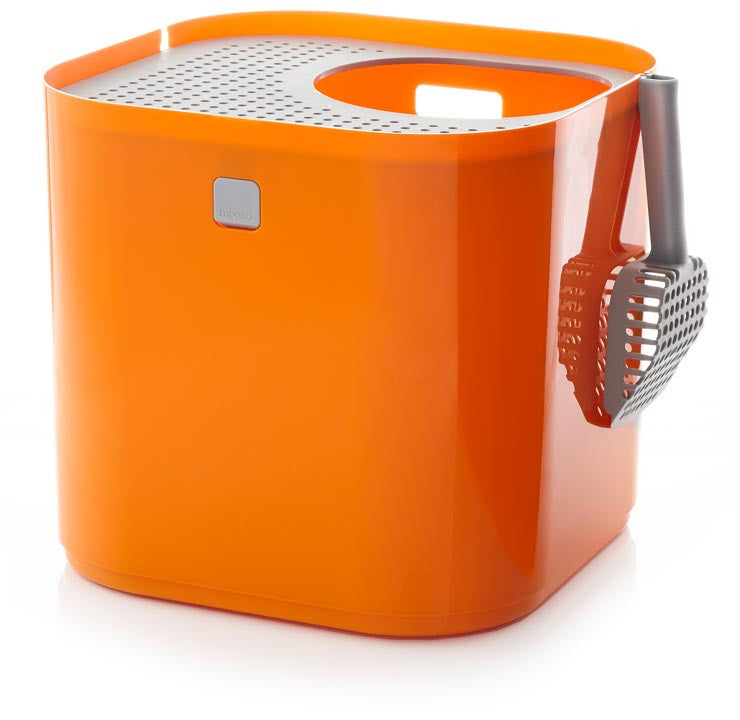What Types of Cat Litter Boxes Are There?

What Types of Cat Litter Boxes Are There?
If you’ve ever stood in the pet store aisle staring at litter boxes for way too long, you’re not alone. We’ve all been there. There’s the basic tray. The covered kind with the swinging door. Some fancy one that looks like a spaceship and plugs into a wall. And if you’re just trying to keep your cat happy (and your floor clean), the choices can feel a little overwhelming.
So — what types of cat litter boxes are there?
And which one actually makes sense for your cat?
The Classic Open Tray
This is the one you’ve seen everywhere. No lid, no gadgets, just a wide, shallow box that’s easy to scoop and even easier to clean. It might not win any design awards, but cats usually like it. It’s simple. It’s familiar. There are no surprises.
Vets and behaviorists often recommend these because they don’t trap odor and they don’t mess with a cat’s sense of security. Your cat can see everything, smell fresh air, and get in and out without acrobatics. For kittens, seniors, or cats who don’t love confined spaces, this is a solid starting point.
Covered Boxes: Privacy or Problem?
Covered boxes sound great on paper. They hide the mess, control the smell a bit better, and look more like a piece of furniture than a bathroom. And some cats genuinely like the privacy.
But others? Not so much.
A lid can trap smells and make the box feel stuffy, especially if it’s tight on space. A covered box that’s too small is a common reason cats start eliminating outside the box.
If you do go with a covered setup, be sure it’s roomy, well-ventilated, and paired with a litter that actually controls odor rather than masking it — like Boxiecat’s vet-recommended, fragrance-free formula.
Especially for larger cats or older ones with arthritis, comfort matters. They need space to turn around, stretch, and feel secure.
The Mysterious Top-Entry
Okay, top-entry boxes definitely get points for design. They’re sleek, they keep litter inside the box, and they might even keep your dog from poking its nose where it doesn’t belong.
The idea is simple: your cat jumps on top, goes through a hole in the lid, and does their thing. When they hop out, the extra litter on their paws falls back in — which means less tracking across your floors.
But here’s the thing. Not all cats are gymnasts. Some don’t like the drop-in feeling. And for seniors or cats with mobility issues, it’s just not going to work.
High Sides for High Sprayers
If your cat likes to dig like they’re heading to the Earth’s core, or if they have a habit of spraying high, you’ve probably dealt with the joys of litter on the walls. High-sided boxes are made for this.
They don’t fix everything, but they definitely cut down on the mess.
Just watch the entry height. A box with tall sides and no low front might be too much of a jump for a cat that’s older or has joint issues.
That Weird Corner Box
We get it. Not everyone has a spare laundry room just waiting to host a litter setup. If you’re working with a bathroom corner or awkward closet, those triangle-shaped boxes can actually be a lifesaver.
They tuck into tight spots, and if your cat’s okay with a little less room to move around, it can be a totally fine solution.
Just check the size. A corner box that’s too cramped will get rejected real fast.
Self-Cleaning Litter Boxes: Dream or Drama?
This is where things get high-tech.
Self-cleaning boxes promise less scooping, less smell, and more free time for you. And when they work? They’re amazing.
But not all cats trust them. The noise, the movement, even just the fact that the litter feels different — it’s a lot. And if anything malfunctions, you could end up with a very expensive mess.
If you’re curious about trying one, test it slowly. Don’t throw away the old box just yet.
Hidden Boxes That Look Like Furniture
These are great if you want to hide the litter box in plain sight. They come disguised as benches, cabinets, planters — you name it. And honestly, they look nice.
But here’s the thing: ventilation matters. If the hidden compartment is too small or holds onto moisture and odor, your cat won’t use it, and you won’t be able to blame them.
They’re best for cats who are already litter pros, and homes where you want to minimize the visual impact of your litter setup without sacrificing function.
So Which One Should You Choose?
Start simple.
Start with what works.
Most cats are perfectly fine with an open, odorless, easy-to-scoop box — especially when paired with a clean, low-dust litter like Boxiecat Unscented Clumping Clay.
And the more complex you go, the more you need to observe — is your cat comfortable? Do they hesitate? Are they eliminating outside the box?
Litter box issues aren’t just a cleaning problem. They’re a communication issue. If your cat is telling you something’s wrong, it might be the box, not the behavior.
Try a box that’s easy to get into, easy to clean, and gives your cat space to move around. Skip the scent. Go unscented and odorless. That’s what they’re asking for.
- Tags: Litter Boxes

